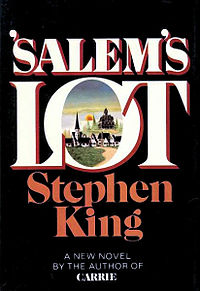By STEPHEN KING (Knopf; 1975)
This wasn’t the first novel by Stephen King (it followed 1974’s CARRIE), but it was the book that really announced to the world what King was all about, and changed the horror genre forevermore. Indeed, there’s a school of thought proclaiming any horror novel that doesn’t contain at least some of the elements introduced in ‘SALEM’S LOT—a small town, a supernatural invasion resisted by the efforts of common folk, a sappy romance–is somehow wrong.
The town in question is the fictional Jerusalem’s Lot of Maine, and the supernatural entity a gaggle of vampires led by Straker, an antiques dealer patterned after a certain Count Dracula who moves into a forbidding old house that overlooks the town. The romance occurs between the novel’s hero Ben Mears, a novelist, and Susan Norton, an attractive artist in whose presence Ben “felt sixteen.” The fact that this puppy dog romance ends horribly (hint: one of the two doesn’t survive), and does so long before the novel’s conclusion, is evidence that King was at the beginning of his career, and not as bullish about happy endings as he later became.
One definite harbinger of things to come from Mr. King is the sprawling epic canvas (as opposed to CARRIE’S lean and intimate construction), which is nonetheless a lot more focused than those of his later novels. The many characters, who include several assorted hicks and a plucky kid who becomes one of the primary vampire killers, are all well delineated, and the rural Maine scenery vividly and atmospherically evoked. Unlike quite a few of the countless horror epics that followed, ‘SALEM’S LOT’S panoramic canvas actually works to its advantage in the way it convincingly conveys the step-by-step takeover of Jerusalem’s Lot by the vamps until the place is a literal ghost town, and does so with some spectacularly gruesome set-pieces.
On the downside, the action is often quite repetitive (there are a few too many appearances by vampires hovering outside peoples’ windows) and implausible (such as a tied-up character freeing himself by thinking back to a Houdini biography he once read). ‘SALEM’S LOT’S biggest problem, however, is simply that its once-innovative structure has been so widely emulated in the ensuing years that it now seems old hat. There’s also the fact that, again in keeping with many of Stephen King’s later novels, the conclusion is bit of a let-down. In 1975 nobody apparently minded the muted and inconclusive final pages, but modern standards call for something more.

